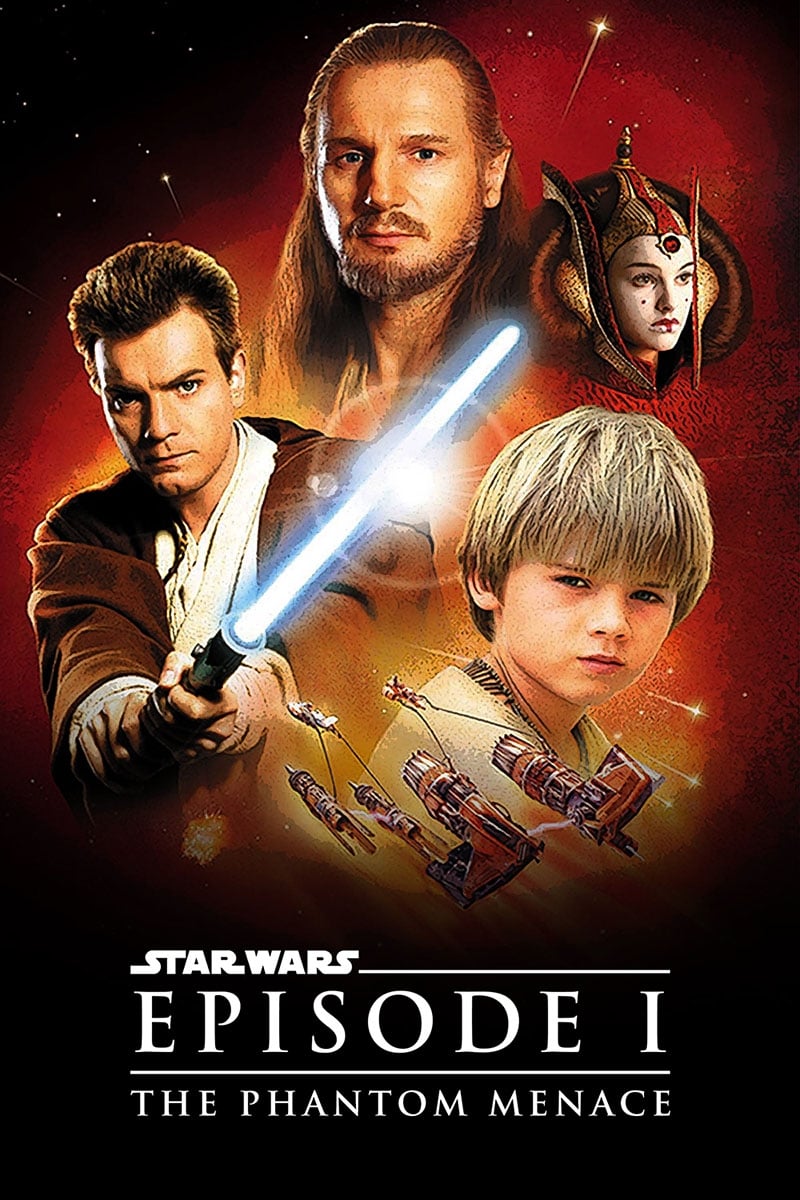
04 May Star Wars Episode I: The Phantom Menace Review
STAR WARS EPISODE I: THE PHANTOM MENACE
dir. George Lucas, starring Liam Neesons, Ewan McGregor, Natalie Portman, and apparently Jake Lloyd
On May 19, 1999, Star Wars Episode I: The Phantom Menace was released and the world lost its goddamn mind.
The first new Star Wars movie since 1983’s Return of the Jedi, The Phantom Menace told a tale of politics, shadowy machinations, and the discovery of a young boy who would grow to be the galaxy’s greatest mass murderer. While widely maligned upon its release, the film has in recent years garnered support from a younger generation that grew up on the prequel trilogy. There’s good elements that can be mined from Lucas’ muddied and convoluted foray back into the world he created – Darth Maul’s design, Ewan McGregor’s Obi-Wan Kenobi, the duel of the fates – but overall, the director’s tunnel vision aimed at new technology in filmmaking is his most egregious sin. Admittedly, Lucas’ hyper focus on technological precision granted us a superb second act action sequence in the Boonta Eve pod race, which features an ingenious combination of sound design and sound editing. Still, these inspired moments are far and few in between as the movie largely feels like Lucas is merely going through the motions of making a film, not heralding a triumphant return to the franchise that made him.
Starring Liam Neesons and Ewan McGregor as Qui-Gon Jinn and Obi-Wan Kenobi respectfully, The Phantom Menace provides the audience and Star Wars fans with something they’ve only been able to imagine in their heads: Jedi in their prime. A far cry from the stiff, shuffling, you-can-almost-smell-the-Ben-Gay fight scene of A New Hope, here we have Jedi that are spry, light on their toes, and ready for action. Liam Neeson, serving in a mentor role, fills the screen with his presence as Jedi Master Qui-Gon Jinn. It’s unfortunate we only get Qui-Gon for one outing, as he captivates the screen as a poised, confident, sly, and somewhat mischievous elder statesman. A brilliant casting decision, Neesons uses his tall stature when playing Qui-Gon to stand out and quickly take control of situations. While the Taken franchise was a fun start to the Old Men in Action subgenre, it’s Neesons’ role here in Phantom Menace that makes me wish we got more roles with him as a confident leader of people.
For all Qui-Gon’s charm (not to mention chemistry with Shmi Skywalker, George dropped the thermal detonator on that one), Ewan McGregor’s Obi-Wan Kenobi is far and away the best thing to come out of this misfire of a film. Long since hailed as one of the saviors of the prequel trilogy, McGregor put everything into the role of Obi-Wan Kenobi. One of two actors in the film playing a character after a different actor made it iconic (the other being Jake Lloyd), McGregor’s turn as one of the franchises most beloved characters took Sir Alec Guinness’ molding of Ben and gave it dimension, shape, and form. While relegated from the second act as he stays behind on the ship to keep an eye on the citizens of Naboo, McGregor really shines in the third act as Obi-Wan is forced to step up after Qui-Gon’s noble end at the hands of Darth Maul. It’s this scene, the final battle between Maul and Kenobi, that cemented McGregor as Kenobi while giving the fans an excellently choreographed fight scene. While his role would continue to grow in Attack of the Clones and slightly wane in Revenge of the Sith, here in Phantom Menace, McGregor manages to impress and survive the lack of clear direction from Lucas.
Also starring Natalie Portman as regal Queen Amidala, she’s unfortunately one of the actresses who suffers the worst from Lucas’ directing failures. Stiff, wooden, and almost devoid of any emotion, Portman hits her marks and delivers her lines with all the enthusiasm and charm of a Hutt. Having already seen her in films like Léon: The Professional and Mars Attacks before this, we know Portman is capable of great performances, but here in The Phantom Menace the subpar delivery can be mostly laid at the feet of the film’s director. While playing a coyly dual role of both Queen Amidala and Padme, one of the Queen’s handmaidens (honestly, probably Lucas’ best idea for this movie outside of Darth Maul), Portman doesn’t do much to distinguish between the two characters, outside of makeup and dress. Tagging along with Qui-Gon and R2D2 on their adventures on Tatooine, Padme has little to do outside of meeting Anakin Skywalker. Much like Ewan McGregor, Portman’s presence grows in Attack of the Clones before waning in Revenge of the Sith, but her performance in The Phantom Menace is one fans of the actress are likely happy to forget.
Rounding out the principal cast are Jake Lloyd and Ian McDiarmid as Anakin Skywalker and Senator Palpatine. There’s not much to say about Jake Lloyd in this movie; at 10 years old, playing the kid of one of pop culture’s most famous villains, Lloyd was placed in an impossible situation. Still, he tries his best, and at time manages to pull off a good performance, especially in the dinner scene with his mother. Outside of that, Lloyd is a victim of suspect writing and negligent direction. Ian McDiarmid, reprising his role as Daddy Shiv Palpatine, leans full into the villainy from the jump. Deciding not to hide the fact that this is the same man who will shortly have the galaxy in a vice grip due to his careful manipulation, strongarm tactics, and outright dickishness, McDiarmid starts here in The Phantom Menace as an actor who’s clearly enjoying himself (he’ll go full tilt in Revenge of the Sith and it’s glorious). Still, having to play the subdued Senator from Naboo whispering ill advice in the ear of Queen Amidala while also directing his apprentice to the murder of hundreds, Ian McDiarmid started strong as the Emperor in Return of the Jedi and continued his strong run with The Phantom Menace.
Star Wars visionary and multimedia figurehead George Lucas returns to the director’s chair for the first time in the Star Wars universe since its inception in the 1977 sensational blockbuster. Then, Lucas became an overnight success and helped usher in a new age of popcorn-fueled films that helped redefine culture. The Phantom Menace, unfortunately, does little to compare to Lucas’ previous outing, providing the audience with an overly polished, squeaky-clean world that focused more on Lucas’ love of burgeoning technology than plot or character. Having previously fallen victim to this with the 1990’s special edition releases, forever altering the original theatrical runs, Lucas quadruples down in The Phantom Menace; while the practical elements of the movie look good thanks to DP David Tattersall, the overuse of blue screen backdrops and heavy CGI elements detract from the overall film. Giving the actors little to work off of or immerse themselves in besides each other, this digital wash leaves the film feeling sterile, too pristine, and totally separated from the previous three movies. Lucas’ obsession with technology, along with his notorious inability to direct his actors, reveals him to be a better storyteller than actual story maker.
To that end, Lucas’ decision to have an entry into a series widely known for its appeal amongst children be so bogged down with issues of taxation and senate squabbles makes for a barren wasteland of fun and adventure. A New Hope begins with a bang and only lets up to develop characters and relationships, The Phantom Menace’s second act of political maneuvering brings the film’s pacing to a crawl. From an overhead perspective, Lucas’ story of Palpatine using the Nemoidians to disrupt things in Naboo to kick start his entire operation makes sense when looked at from a macro perspective, but from the audience’s viewpoint when in the film, the politics of it all couldn’t be less entertaining.
Composer John Williams does what he can, returning to the franchise he helped cement to provide new themes, leitmotifs, and of course The Duel of the Fates, one of the most iconic pieces of music in Star Wars. Williams continues his perfect track record by infusing the film with gentle melodies for Padme, blasting trumpets for the pod race introduction, and low, menacing tones of the Sith all interweaving to create a tapestry that can be enjoyed by itself just as much (if not more) than with the film itself.
Overall, Star Wars Episode I, while not the worst film in the franchise, is riddled with issues, from story to pacing to acting. Some of the more questionable decisions made regarding the alien species, specifically the Nemoidians and the Gungans, leaves the audience a bit confused if not downright offended at what can be seen (intentional or not) as a negative reinforcement of Asians and Caribbean Islanders. The standout elements of the movie; Ewan McGregor, the third act lightsaber battle, and John Williams’ bombastic score, aren’t enough to save what ultimately hails as a misguided opening salvo to herald a new franchise and the return of Star Wars.
Review by Darryl Mansel


No Comments